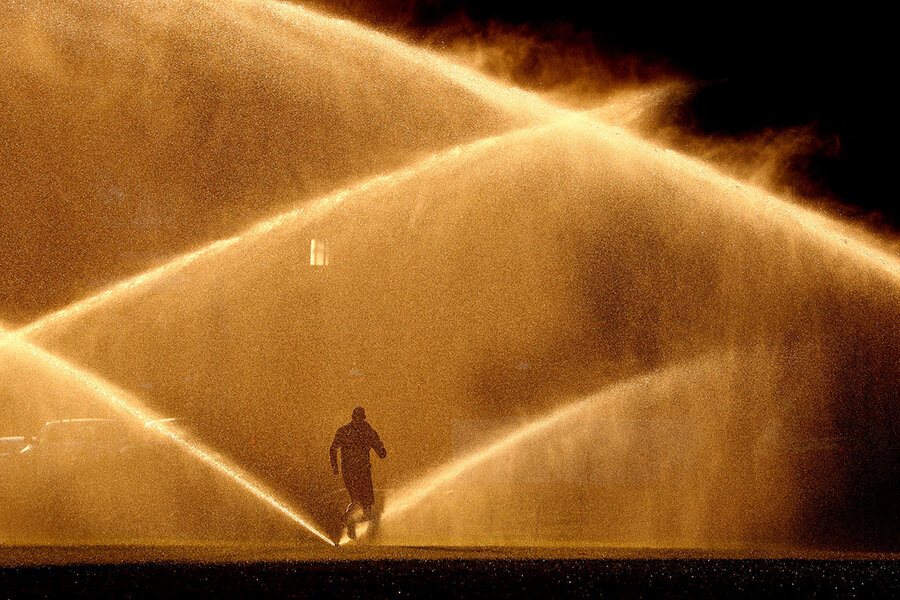Why Americans are using a lot less water
Loading...
The average American is using a lot less water on a daily basis. Six gallons less, to be exact.
The US Geological Survey’s National Water Use Science Project has estimated water use in the United States every five years since 1950. In its most recent estimate published this fall, the USGS found that American daily water use per capita went from 88 gallons in 2010 to 82 gallons per capita in 2015.
Conservation of fresh water is important because it is a limited resource: Less than 1 percent of all the water on Earth can by used by humans. With growing populations and changing climates, fresh water is becoming increasingly valuable, says Edward Osann, a senior policy analyst and water efficiency project director at the National Resources Defense Council.
“One of the effects of climate change is we are seeing more extremes: more substantial droughts, followed by substantial floods,” says Mr. Osann. “If we can sustain ourselves while using less fresh water, we will be more resilient while going into these fluctuations in the hydrologic cycle of the future.”
The US population grew by 4 percent between 2010 and 2015, or 12 million people, but total withdrawals for public supply – water that comes out of kitchen faucets and lawn sprinklers – decreased by 7 percent. According to the USGS, total public-supply withdrawals were at their lowest levels since 1995.
Household water use in the United States has been tracking downward since President George H.W. Bush signed the Energy Policy Act of 1992, says Osann. October 2017 marked the 25th anniversary of the policy, which required the first national standards for water efficiency in new consumer products such as faucets, shower heads, and toilets. For example, the law required a change in toilet water use from 3.5 to 5 gallons per flush, to a mandated 1.6 gallons or less.
But while the country is using less water, many Americans are still receiving expensive water bills. Joseph Kane, senior research associate at the Brookings Institution’s Metro Policy Program who focuses on issues of water and infrastructure, explains that although water utility companies are not in the business of making money, they still need to ensure they have the revenue needed to repair infrastructure that is between 50 and 80 years old.
“We’re at a time of great maintenance and replacement needs,” says Mr. Kane. “The challenge beyond increased sustainability and efficiency is the issue of affordability.”
Along with improved product efficiency, droughts in the country’s two most populous states – California and Texas – were significant drivers of water use decline in 2015, says Cheryl Dieter, a hydrologist with the USGS and coauthor of the recent report. Together, California and Texas accounted for 78 percent of the nationwide water use decline, due to drought-related restrictions. “A lot of the states had a lot of small decreases,” says Ms. Dieter. “But when things happen in those big states, they affect the overall national trends.”
In January 2014, California Gov. Jerry Brown (D) declared a state of emergency because of the state’s record drought, asking Californians to reduce their water use by 20 percent. In 2015, Governor Brown increased his request to 25 percent.
To reach this goal, the state and local governments have imposed stricter water use regulations. While the national toilet-flush standard is 1.6 gallons per flush, California lowered its standard in 2016 to no more than 1.28 gallons of water per flush.
“As much as people turn toward Washington, a lot of the solutions we are seeing are coming from the bottom up, from states and localities,” says Kane. “These times of drought and greater climate uncertainty are compelling many communities to start deciding what their longer-term strategies are.”
And while Texans reduced their daily use by 46 million gallons a day in 2015, California’s statistics were especially dramatic: The Golden State reduced its water use by roughly 680 million gallons – or 1,030 Olympic-sized swimming pools – per day.
“If they are able to do this right during a period of drought, it does tell a positive story and perhaps give precedent for other regions,” says Kane – regions that, he adds, may not be seeing such be reductions. “What are they doing that other places can learn from?”







